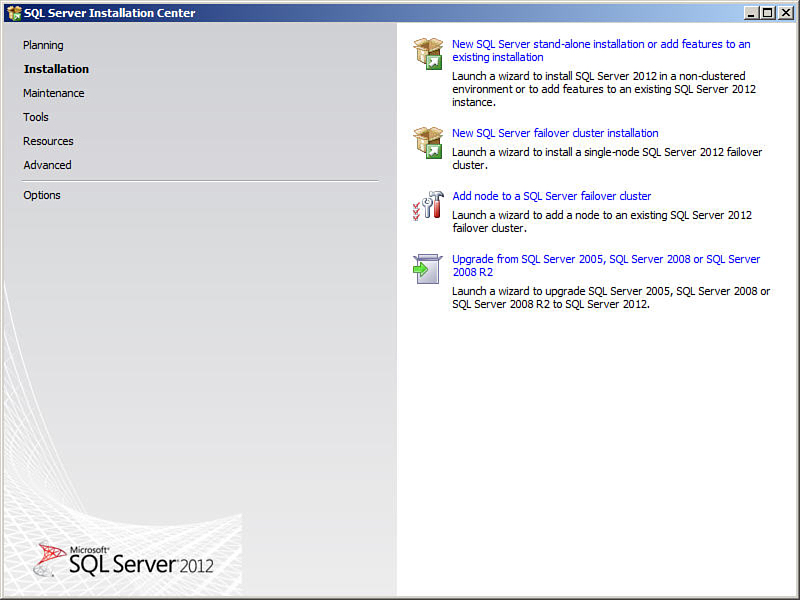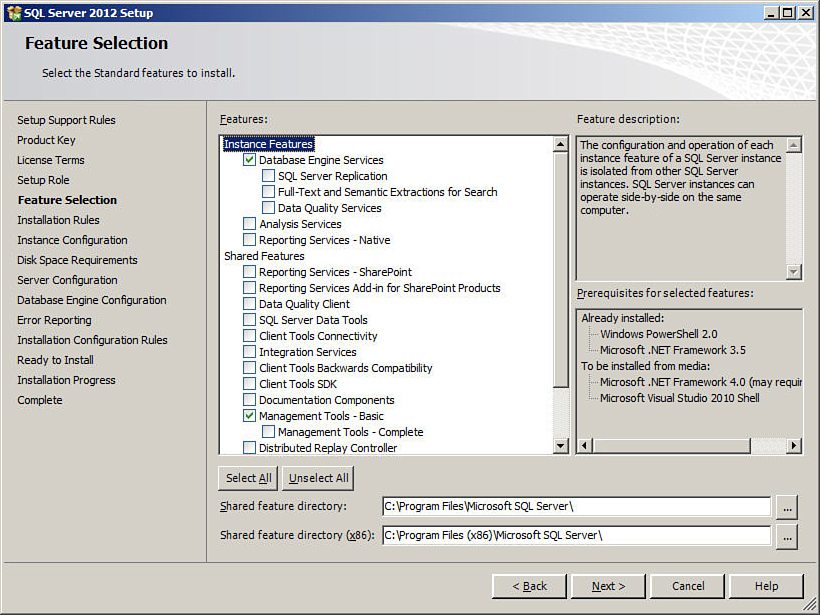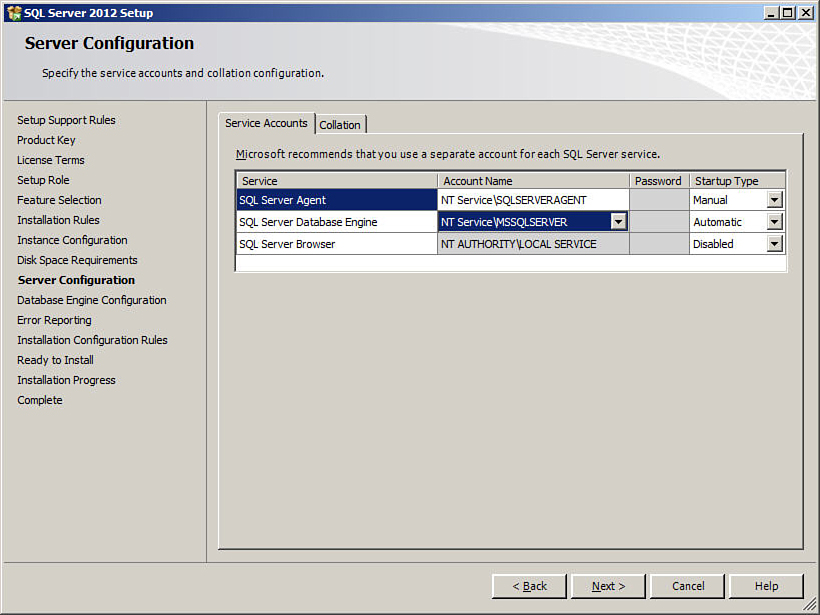Lync Database Requirements
The first SQL database required for a new
Lync installation is the Central Management Store (CMS), which is used
to store the configuration data that is replicated to all the Lync
servers in the environment. Beyond the CMS, the Front End Servers also
require databases for persistent and dynamic user data, and address
book information. Additional databases are also used depending on
specific optional features that might be deployed, such as the Response
Group and Call Park services. Collectively, these databases are
referred to as the Lync Back End databases, and the two database
platforms that can be used for these are SQL 2008 R2 and SQL 2012.
Tip
Either the Enterprise or Standard Editions of
both SQL 2008 R2 and SQL 2012 can be used for the Lync Back End
databases. Both editions also support SQL mirroring, which is the
recommended high-availability solution for the Lync 2013 Back End
databases.
Depending on the topology, it is also
possible to collocate databases that are used by other Lync server
roles with Lync Back End databases. For example, the Archiving and
Monitoring Server roles both have their own databases, and both can be
installed on the same SQL instance as the Lync Back End databases. The
Persistent Chat databases can also be installed on the same SQL system
with the Lync Back End databases. The decision as to whether to
collocate these databases on the same SQL system with each other or
with the Lync Back End databases is largely a matter of whether
performance requirements can be met. With that in mind, these
configuration decisions need to be considered on a case-by-case basis.
All the database collocation possibilities mentioned previously are
applicable to Enterprise Edition pools only. This is because the
Standard Edition uses SQL Express, which does not meet the database
requirements for any of the other Lync server roles.
Note
Microsoft supports installation of
the Back End, Monitoring, Archiving, and Persistent Chat databases on
the same SQL Server, and these can use either the same SQL instance or
separate instances. However, only one of each type of database is
supported on any given SQL Server. For many Lync deployments, only one
of each type of database is actually required, however there are
circumstances in which more than one of a certain database might be
needed. For example, the Monitoring Server role can only be associated
with a single Front End pool. In a Lync environment with multiple
pools, this means that several Monitoring Server databases, and
therefore several SQL Server systems, would be needed to provide
monitoring for the entire environment.
Installing SQL Server for Lync
As noted earlier, for an Enterprise Edition
pool, SQL Server 2008 R2 and SQL Server 2012 are the supported Back End
database platforms. Since it is the most recent database release, this
section provides step-by-step procedures for installing SQL 2012 in
preparation for hosting the Lync Server 2013 Back End databases.
However, installation of SQL 2008 R2 for Lync involves very similar
steps. To install SQL Server 2012 in preparation for Lync Enterprise
Edition, perform the following steps:
1. Double-click setup.exe on the SQL 2012 DVD.
2. If the .NET
Framework is not already present, an installation prompt appears. Click
OK to enable installation of the .NET Framework Core.
3. When the SQL Server Installation Center displays, as shown in Figure 1,
click Installation in the left pane, and then click New SQL Server
Stand-Alone Installation or Add Features to an Existing Installation.

Figure 1. SQL Server Installation Center.
4. A first round of
setup support rule checks now runs automatically, identifying any
problems that might need to be corrected before the installation
continues. If any failures occur, click the status for additional
information and follow the recommended steps to remediate the problem.
After all rule checks pass successfully, click OK.
5. At this point the
setup files are installed, followed by a second set of setup support
rule checks. If any failures occur, click the status for additional
information and follow the recommended steps to remediate the problem.
After all rule checks pass successfully, click Next.
6. At the Product Key screen, enter your product key and click Next.
7. Read the licensing terms. If you agree, select I Accept the License Terms and then click Next.
8. When the Setup Role screen appears, choose SQL Server Feature Installation and click Next.
9. The Feature Selection screen now appears, as shown in Figure 2.
For a Lync Enterprise Edition installation, Database Engine Services is
the only feature that is required. However, Management Tools - Basic is
recommended for maintenance and troubleshooting purposes, and SQL
Server Replication should be installed if SQL mirroring will be used
for high-availability. Other features can be installed if desired. After
selecting the features to be installed, either keep the default
installation paths for SQL shared features or enter an alternative path
for these files, and click Next.

Figure 2. SQL Feature Selection.
10. Installation
rules are now checked to identify any problems that block installation.
If any failures occur, click the status for additional information and
follow the recommended steps to remediate the problem. After all rule
checks pass successfully, click Next.
11. At the Instance
Configuration screen, select the option for Default Instance, and keep
the default settings for Instance ID and Instance root directory. Click
Next.
12. At the Disk Space Requirements screen, review the disk space usage summary and click Next.
13. The Server Configuration screen now appears, as shown in Figure 3.
For Lync, the default configuration of using built-in service accounts
will suffice; however, dedicated domain-based accounts can be chosen if
these have been configured. If dedicated accounts will be used, enter
the account names and passwords for each service. Leave the startup
types at their default values, and click Next.

Figure 3. SQL service accounts configuration.
14. At the Database
Engine Configuration screen, select the Authentication Mode for the
server, either the default setting of Windows Authentication Mode or
Mixed Mode, which allows both SQL and Windows accounts to be used. If
Mixed Mode is selected, enter the initial password for the SQL system
administrator (sa) account.
Tip
Windows authentication is generally
considered to be the more secure authentication method for SQL.
However, mixed mode does provide an additional method of connecting to
SQL in the event that there are problems communicating with Active
Directory, which can be useful for troubleshooting purposes. The
decision of which authentication mode to use should therefore be made
based on the security policy of the organization.
15. Still on the
Database Engine Configuration screen, at the bottom of the screen click
Add, and then use the object picker to select the administrative groups
and users that will be granted unrestricted access to the database
engine. For many organizations, the built-in Administrators group on
the local server will be added here, as shown in Figure 4. click Next.

Figure 4. SQL authentication and administrator accounts configuration.
16. Still on the
Database Engine Configuration screen, click the Data Directories tab to
view the default locations for the data root directory, user database
directory, temp database directory, backup directory, and the user and
temp database log file directories. Either keep the default locations
on the C: volume for each of these, or, if dedicated volumes have been
created in advance, edit the locations to reflect these alternative
locations. When finished, click Next.
17. At the Error
Reporting screen, select whether Windows and SQL Server Error Reports
will be sent to Microsoft, and then click Next.
18.
Installation configuration rules are now checked to identify any
problems that block installation. If any failures occur, click the
status for additional information and follow the recommended steps to
remediate the problem. After all rule checks have passed successfully,
click Next.
19. At the Ready to
Install screen, review the configuration summary to verify that the
correct selections have been made. When finished, click Install to
proceed with the installation.
20. When the installation is completed, click Close.
Tip
After the SQL installation is complete, use Windows Update to search for SQL-related updates.